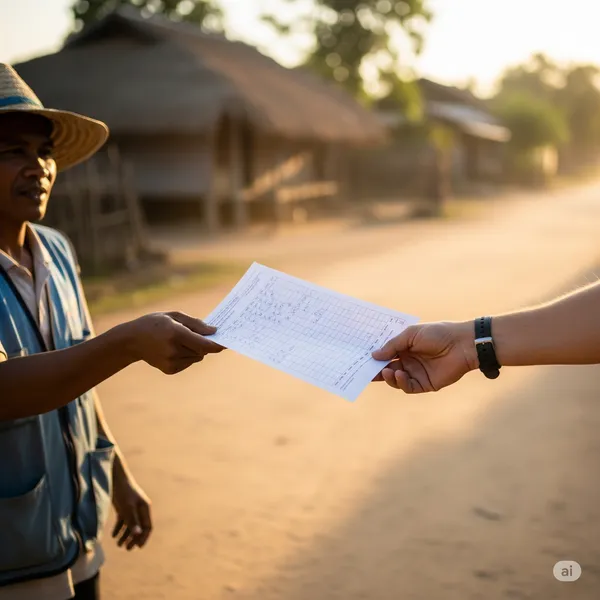Trusted Monitoring in Fragile and Conflict-Affected Situations
Published on: Wed Jun 14 2023 by Ivar Strand
Trusted Monitoring: A Framework for Verification in Fragile and Conflict-Affected Situations (FCAS)
Standard monitoring and evaluation (M&E) frameworks are predicated on assumptions that do not hold in fragile and conflict-affected situations (FCAS). They presuppose a degree of institutional stability, reliable government data, and reasonable physical access—luxuries that are conspicuously absent in the environments where development and humanitarian interventions are often most needed. The core challenge is how to conduct credible, independent verification when access is restricted, security risks are high, and official data sources are unavailable or politically compromised.
In this paper, we discuss a framework for trusted monitoring designed specifically for these complex operating environments. This is about moving beyond compliance-based reporting and toward a system that provides decision-makers with a verifiable and defensible basis for action.
The Limitations of Standard Monitoring in FCAS
Conventional monitoring methodologies typically falter in fragile states for three primary reasons:
- Data Unreliability. National and sub-national data collection systems are often defunct or captured by political interests. Statistics may be intentionally manipulated to secure aid or conceal poor performance, making them an unsound foundation for programmatic assessment.
- Access Constraints. Direct observation by international staff may be impossible due to security threats, logistical barriers, or official access denial. This creates critical information gaps regarding project implementation and outcomes.
- Elevated Fiduciary Risk. The combination of weak governance, nascent institutions, and acute needs creates significant opportunities for the diversion of funds and resources. Standard audits are often insufficient to detect or deter sophisticated forms of corruption in these contexts.
A Framework for Trusted Monitoring
The fundamental idea behind trusted monitoring is to shift the burden of proof from reliance on institutional reporting to independently verifiable, ground-level evidence. At Abyrint, we have found that such a framework must be built on three core principles.
- 1. Mandated Independence. The monitoring agent must be—and must be perceived as—operationally and politically independent from the implementing parties and the host government. This impartiality is the bedrock of credibility. Its findings must be resistant to influence and reported without filtering.
- 2. Systematic Triangulation. No single source of information can be fully trusted in an FCAS environment. A robust monitoring system systematically cross-references data from multiple, uncorrelated sources. This can include a mix of direct observation, remote sensing (e.g., satellite imagery), beneficiary interviews, community-level reporting, and analysis of open-source information. The goal is to identify points of convergence and divergence that reveal the ground truth.
- 3. Proportionality of Effort. Not all activities carry the same level of risk or strategic importance. The intensity and methodology of verification must be proportional to the fiduciary risk and programmatic value at stake. A low-value agricultural inputs program does not require the same level of assurance as a high-value, direct cash payment system in a contested area.
Implementing Trusted Monitoring: A Tiered Approach
Applying these principles requires a flexible, risk-based methodology. We suggest three archetypical models, which can be adapted and combined based on the specific context.
- Tier 1: Remote Verification. For activities in inaccessible areas or with lower programmatic risk, remote techniques provide a baseline of assurance. This includes the use of geospatial analysis to verify infrastructure construction, call centers to survey beneficiaries, timestamped photos submitted by field staff, and analysis of local media and market price data. While not foolproof, it is a cost-effective way to monitor trends and flag anomalies for further investigation.
- Tier 2: Third-Party Monitoring (TPM). This is the most common model for trusted monitoring. It involves contracting a specialized, independent organization to deploy local enumerators to conduct physical site visits, beneficiary interviews, and direct observation. The key challenge is ensuring the quality and integrity of the data collected by local teams. This requires rigorous training, clear protocols, strong supervision, and frequent back-checking and cross-validation of findings.
- Tier 3: Embedded Assurance. For the highest-risk and highest-value interventions—such as managing payment flows for security sector stipends or distributing high-value medical supplies—a more intensive approach is warranted. Embedded assurance involves placing highly vetted monitors directly within the implementation process to observe and verify critical functions in real-time. This approach is resource-intensive but provides the highest level of confidence that processes are being followed and resources are reaching their intended destination.
The selection of a tier is not static; it is a function of risk and access, as illustrated below.
Exhibit A: The Trusted Monitoring Matrix (A conceptual matrix shows “Programmatic Risk / Value” on the Y-axis (Low to High) and “Operating Environment Accessibility” on the X-axis (High to Low).)
- Low-Risk / High-Access quadrant: Standard program M&E may suffice.
- Low-Risk / Low-Access quadrant: Tier 1 (Remote Verification) is appropriate.
- High-Risk / High-Access quadrant: Tier 2 (TPM) provides a robust solution.
- High-Risk / Low-Access quadrant: Tier 3 (Embedded Assurance) is necessary.
Conclusion: From Compliance to Confidence
In fragile and conflict-affected situations, monitoring cannot be treated as a simple compliance exercise. It is a strategic function that directly enables program adaptation, mitigates significant fiduciary and reputational risks, and ensures accountability to both donors and beneficiaries.
Adopting a structured framework for trusted monitoring is not about achieving perfect information, which is an unrealistic goal. It is about building a sufficiently credible and resilient evidence base to make informed decisions in environments where trust is scarce and facts are contested. Ultimately, this approach provides the confidence needed to continue operating effectively where help is needed most.



